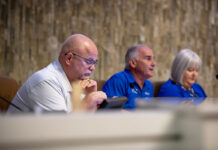
Street corners dotted with portable A-frame signs could have a cleaner appearance by summer.
The growing number of small sandwich board-style signs throughout the city has drawn negative attention from some residents, prompting city officials to consider the issue as they move forward with rewriting Maricopa’s zoning code.
“Ten years after incorporation, it’s now the time that we need to create our own city zoning code that’s designed for the city of Maricopa and not one that is done in the 50s or 60s, which doesn’t help us in our current situation as a growing city,” said City Planner Rodolfo Lopez.
The zoning code was adopted from the Pinal County Code when Maricopa was incorporated, officials said. The sign code is just one portion of the zoning code, which officials plan to rewrite and then make available to the community during an open forum prior to beginning the adoption process.
In response to the economic downturn in 2009, city officials allowed businesses to extend the duration of the time banner signs could be displayed and started permitting portable signs. But the number of signs has grown, leading to a cluttered appearance that some fear is affecting the city’s image.
“We want to find the middle ground, to help keep the businesses intact, but also keep the visual appeal of the street corner,” Lopez said. “The code that we’re drafting should address that.”
A few of the solutions on the table are to impose a limit on the number of signs and the distance they can be located from one another. As well, officials want to encourage the use of monument signs, which are the large free-standing signs often built in shopping centers and feature multiple businesses on each sign.
Ceylan Gentilella, owner of Desert Sun Performing Arts in Maricopa, said her company uses both a monument sign and two A-frame signs, but her A-frame signs are most effective.
“Because we’re south facing, it’s difficult to see the dance school,” she said.
Gentilella said she has been relying on her cost-effective A-frame signs for the nearly eight years she has been open for business in Maricopa – and the signs regularly result in walk-in business.
“If they are going to start placing restrictions on these, I would lose a lot of faith,” Gentilella said.
She wants city officials to do everything in their power to encourage the local business community, especially after the economic decline that destroyed many small businesses.
“I’d like a voice,” Gentilella said. “I’d like the city to approach the businesses … so there is a compromise.”
“Everybody is trying to survive,” she added. “It’s an epidemic of business closures and we lack the support that we need to be effective.”
Josh Beasley, who oversees installations for his father’s Radio Shack, said his company’s A-frame sign also is effective for bringing customers into his family’s store. However, Beasley said he has noticed the number of A-frame signs surrounding his sign has increased in recent months and he worries they could impact his store’s visibility.
“The more of them you can see, you can’t see ours,” Beasley said. “I think it’s too much for anyone to read them when you’ve got 10 A-frames right in the same section.”
Beasley said he’s happy to share signage space with other businesses nearby, but he doesn’t like when businesses located far away or online place signs among his business and his neighbors’ signs.
Maricopa Economic Development Director Micah Miranda said he would like to see signs that are more visible in both day and night and do not obstruct the sidewalk or bike paths.
“Part of economic development is creating a clean, nice city and when you have a bunch of signs and guys waving their arm … the original sign message is now lost in a sea of signs,” Miranda said.
He added, “If you have one A-frame out, then the next business is going to put one in front of that and it keeps going, and then you have 30 A-frames on the sidewalk and it creates a safety hazard.”
Miranda agreed that monument signs would be the best solution to help businesses display their names prominently, while maintaining a clean-looking city.
Maricopa residents have mixed feelings about the presence of A-frame signs and shared their thoughts on Facebook.com/InMaricopa.
“Sandwich boards imply ‘temporary,’” said resident Tracy Davis. “Don’t we want to create an ambiance of welcoming businesses to open and remain here?”
Sevina Pegue said she hates the sandwich board signs and is skeptical if they are actually making an impact on business development.
“It feels very small town and looks junky,” Pegue said.
Resident Kim Greene Viens said she doesn’t mind them.
“I see no problem with it as long as it’s in good taste and helps bring business to Maricopa,” she said.
Under the current code, the A-frame signs must be located in industrial or business zoning districts, cannot be taller than three feet or larger than eight total square feet, must be located within 300 feet of the business or commercial center where the business is located, and has to be set back seven feet from the curb and never within sign visibility triangles.




![In mayoral race, it’s the Nancy Smith show Maricopa Chamber of Commerce Executive Director Kelly Anderson grills incumbent Mayor Nancy Smith in election's first campaign event April 30, 2024, at Southern Dunes Golf Club. [Elias Weiss]](https://www.inmaricopa.com/wp-content/uploads/2024/04/CRM_1009-218x150.jpg)
![City gave new manager big low-interest home loan City Manager Ben Bitter speaks during a Chamber of Commerce event at Global Water Resources on April 11, 2024. Bitter discussed the current state of economic development in Maricopa, as well as hinting at lowering property tax rates again. [Monica D. Spencer]](https://www.inmaricopa.com/wp-content/uploads/2024/04/spencer-041124-ben-bitter-chamber-property-taxes-web-218x150.jpg)
![3 things to know about the new city budget Vice Mayor Amber Liermann and Councilmember Eric Goettl review parts of the city's 2024 operational budget with Mayor Nancy Smith on April 24, 2024. [Monica D. Spencer]](https://www.inmaricopa.com/wp-content/uploads/2024/04/spencer-042424-preliminary-budget-meeting-web-218x150.jpg)




![Maricopa restaurateur makes Food Network connection [Namkeen Dhaba]](https://www.inmaricopa.com/wp-content/uploads/2024/04/439456716_377105198650519_7536248579664805896_n-218x150.jpg)
![Merging lanes incite more 347 anger A merging lane sign sits on the side of State Route 347 northbound lanes during evening traffic on April 30, 2024. [Monica D. Spencer]](https://www.inmaricopa.com/wp-content/uploads/2024/04/spencer-043024-adot-merging-lanes-347-web-218x150.jpg)




